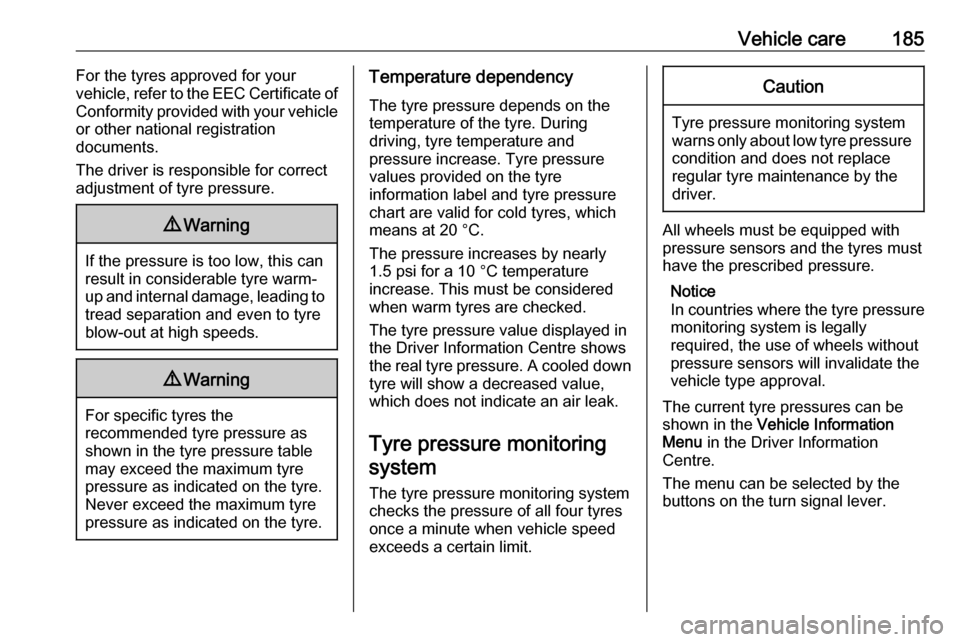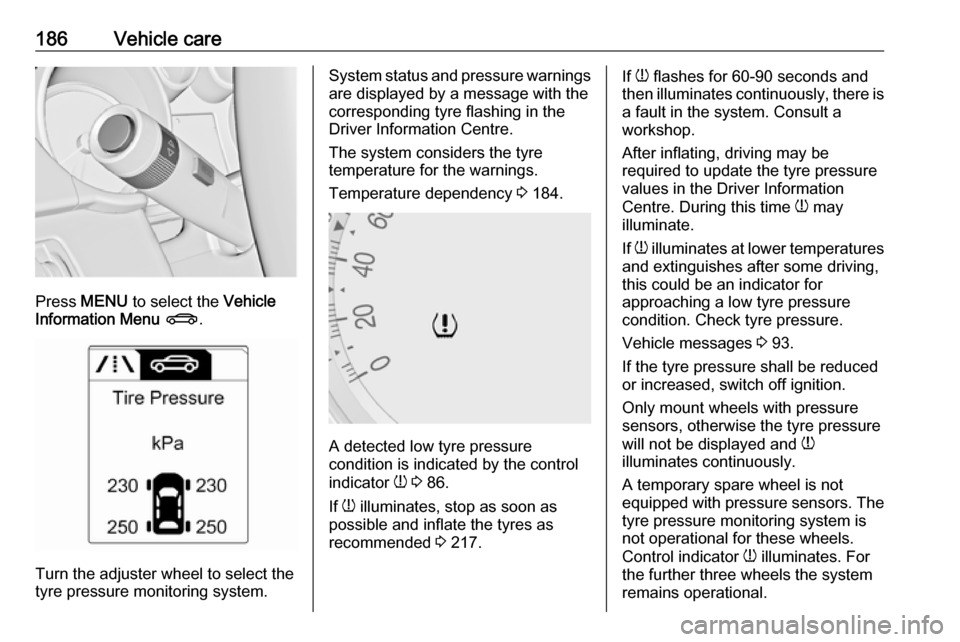wheel VAUXHALL MOKKA 2016.5 Workshop Manual
[x] Cancel search | Manufacturer: VAUXHALL, Model Year: 2016.5, Model line: MOKKA, Model: VAUXHALL MOKKA 2016.5Pages: 231, PDF Size: 6.57 MB
Page 164 of 231

162Vehicle careVehicle careGeneral Information...................163
Accessories and vehicle modifications .......................... 163
Vehicle storage ........................163
End-of-life vehicle recovery .....163
Vehicle checks ........................... 164
Performing work ......................164
Bonnet ..................................... 164
Engine oil ................................. 165
Engine coolant ......................... 166
Power steering fluid .................167
Washer fluid ............................ 167
Brakes ..................................... 168
Brake fluid ............................... 168
Vehicle battery ......................... 168
Diesel fuel system bleeding .....170
Wiper blade replacement ........170
Bulb replacement .......................171
Halogen headlights ..................171
Xenon headlights .....................173
Fog lights ................................. 174
Front turn signal lights .............174
Tail lights ................................. 175
Side turn signal lights ..............176Centre high-mounted brake
light ......................................... 176
Number plate light ...................177
Interior lights ............................ 177
Electrical system ........................178
Fuses ....................................... 178
Engine compartment fuse box . 178
Instrument panel fuse box .......180
Load compartment fuse box ....181
Vehicle tools .............................. 183
Tools ........................................ 183
Wheels and tyres .......................183
Winter tyres ............................. 183
Tyre designations ....................184
Tyre pressure .......................... 184
Tyre pressure monitoring system .................................... 185
Tread depth ............................. 188
Changing tyre and wheel size . 189 Wheel covers ........................... 189
Tyre chains .............................. 189
Tyre repair kit .......................... 190
Wheel changing .......................193
Spare wheel ............................ 195
Jump starting ............................. 197
Towing ....................................... 199
Towing the vehicle ...................199
Towing another vehicle ...........200Appearance care .......................201
Exterior care ............................ 201
Interior care ............................. 203
Page 176 of 231

174Vehicle careFog lightsThe bulbs are accessible from the
underside of the vehicle
1. Turn the respective wheel inside to get better access and remove
three torx screws on outside of
wheel house. Vehicle tools
3 183.
2. Pull and hold lining to get access to the bulb holder.
3. Pull the retaining rib (1) outwardsand remove plug connector (2)
from the bulb socket.
4. Turn the bulb holder anti- clockwise (3) and remove it from
the reflector.
5. Remove and replace the bulb socket with bulb and attach the
plug connector.
6. Insert the bulb socket into the reflector by turning clockwise and
engage.
7. Re-assemble the lining and fasten
the three torx screws.
Front turn signal lights
1. Rotate bulb holder anticlockwise and disengage.
Page 183 of 231

Vehicle care181No.Circuit18Rain sensor19Body control module/Regulated
voltage control20Steering wheel21AC accessory power outlet/
Automatic transmission22Cigarette lighter/DC accessory
power outlet23Spare24Spare25Spare26Spare27Instrument panel cluster/Auxil‐
iary heater/Clutch switch28Adaptive forward lighting/
Voltage converter/Headlamp
switch29Spare30SpareNo.Circuit31Instrument panel cluster32Infotainment system/Chime33Display/Infotainment system34Onstar UHP/DAB
S/B Fuses
No.Circuit01Spare02Spare03Power windows front04Power windows rear05Logistic mode06Spare07Spare08SpareLoad compartment fuse box
Located in the left side of rear
compartment.
To access the fuses, remove the cover.
Page 184 of 231

182Vehicle care
Mini Fuses
No.Circuit1Seat, lumbar support, driver2Seat, lumbar support,
passenger3Amplifier4Trailer socket5All-wheel drive6Spare7LPG system8Spare9Spare10Spare11Trailer control module12Spare13Heated steering wheel14Trailer socket15Spare16Water in fuel sensorNo.Circuit17Interior mirror/Rear view
camera18LPG system
S/B Fuses
No.Circuit1Power seat driver2Power seat passenger3Trailer control module4Voltage converter5Battery6Headlight washer7Spare8Spare9Spare
Page 185 of 231

Vehicle care183Vehicle tools
Tools
Vehicles with tyre repair kit
The tools and tyre repair kit are in the
right side of the load compartment.
3 190.
Vehicles with spare wheel
The jack and the tools are in a storage
compartment in the load
compartment above the spare wheel.
Wheel changing 3 193, spare wheel
3 195.
Wheels and tyres
Tyre condition, wheel condition Drive over edges slowly and at right
angles if possible. Driving over sharp
edges can cause tyre and wheel
damage. Do not trap tyres on the kerb when parking.
Regularly check the wheels for
damage. Seek the assistance of a
workshop in the event of damage or
unusual wear.
Winter tyres
Winter tyres improve driving safety at temperatures below 7 °C and shouldtherefore be fitted on all wheels.
All tyre sizes are permitted as winter
tyres 3 217.
In accordance with country-specific
regulations, affix the speed sticker in
the driver's field of view.
Page 186 of 231

184Vehicle careTyre designationsE.g. 215/60 R 16 95 H215:tyre width, mm60:cross-section ratio (tyre height
to tyre width), percentageR:belt type: RadialRF:type: RunFlat16:wheel diameter, inches95:load index e.g. 95 is equivalent
to 690 kgH:speed code letter
Speed code letter:
Q:up to 100 mphS:up to 112 mphT:up to 118 mphH:up to 130 mphV:up to 150 mphW:up to 168 mph
Choose a tyre appropriate for the
maximum speed of your vehicle.
The maximum speed is achievable at kerb weight with driver (75 kg) plus
125 kg payload. Optional equipment
could reduce the maximum speed of
the vehicle.
Performance 3 213.
Directional tyres
Fit directional tyres such that they roll in the direction of travel. The rolling
direction is indicated by a symbol
(e.g. an arrow) on the sidewall.
Tyre pressure
Check the pressure of cold tyres at
least every 14 days and before any
long journey. Do not forget the spare
wheel. This also applies to vehicles
with tyre pressure monitoring system.
Unscrew the valve cap.
Tyre pressure 3 217.
The tyre pressure information label
on the left or right door frame
indicates the original equipment tyres
and the correspondent tyre
pressures.
The tyre pressure data refers to cold
tyres. It applies to summer and winter tyres.
Always inflate the spare tyre to the
pressure specified for full load.
The ECO tyre pressure serves to
achieve the smallest amount of fuel
consumption possible.
Incorrect tyre pressures will impair
safety, vehicle handling, comfort and
fuel economy and will increase tyre
wear.
Tyre pressures differ depending on
various options. For the correct tyre
pressure value, follow the procedure
below:
1. Identify the engine identifier code.
Engine data 3 212.
2. Identify the respective tyre.
The tyre pressure tables show all possible tyre combinations 3 217.
Page 187 of 231

Vehicle care185For the tyres approved for your
vehicle, refer to the EEC Certificate of
Conformity provided with your vehicle
or other national registration
documents.
The driver is responsible for correct
adjustment of tyre pressure.9 Warning
If the pressure is too low, this can
result in considerable tyre warm-
up and internal damage, leading to tread separation and even to tyre
blow-out at high speeds.
9 Warning
For specific tyres the
recommended tyre pressure as
shown in the tyre pressure table may exceed the maximum tyre
pressure as indicated on the tyre.
Never exceed the maximum tyre
pressure as indicated on the tyre.
Temperature dependency
The tyre pressure depends on the
temperature of the tyre. During
driving, tyre temperature and
pressure increase. Tyre pressure
values provided on the tyre
information label and tyre pressure
chart are valid for cold tyres, which means at 20 °C.
The pressure increases by nearly
1.5 psi for a 10 °C temperature
increase. This must be considered
when warm tyres are checked.
The tyre pressure value displayed in
the Driver Information Centre shows
the real tyre pressure. A cooled down
tyre will show a decreased value,
which does not indicate an air leak.
Tyre pressure monitoringsystem
The tyre pressure monitoring system
checks the pressure of all four tyres
once a minute when vehicle speed
exceeds a certain limit.Caution
Tyre pressure monitoring system
warns only about low tyre pressure condition and does not replace
regular tyre maintenance by the
driver.
All wheels must be equipped with pressure sensors and the tyres must
have the prescribed pressure.
Notice
In countries where the tyre pressure
monitoring system is legally
required, the use of wheels without
pressure sensors will invalidate the
vehicle type approval.
The current tyre pressures can be
shown in the Vehicle Information
Menu in the Driver Information
Centre.
The menu can be selected by the buttons on the turn signal lever.
Page 188 of 231

186Vehicle care
Press MENU to select the Vehicle
Information Menu X .
Turn the adjuster wheel to select the
tyre pressure monitoring system.
System status and pressure warnings
are displayed by a message with the
corresponding tyre flashing in the
Driver Information Centre.
The system considers the tyre
temperature for the warnings.
Temperature dependency 3 184.
A detected low tyre pressure
condition is indicated by the control
indicator w 3 86.
If w illuminates, stop as soon as
possible and inflate the tyres as
recommended 3 217.
If
w flashes for 60-90 seconds and
then illuminates continuously, there is
a fault in the system. Consult a
workshop.
After inflating, driving may be
required to update the tyre pressure
values in the Driver Information
Centre. During this time w may
illuminate.
If w illuminates at lower temperatures
and extinguishes after some driving,
this could be an indicator for
approaching a low tyre pressure
condition. Check tyre pressure.
Vehicle messages 3 93.
If the tyre pressure shall be reduced
or increased, switch off ignition.
Only mount wheels with pressure
sensors, otherwise the tyre pressure
will not be displayed and w
illuminates continuously.
A temporary spare wheel is not
equipped with pressure sensors. The
tyre pressure monitoring system is
not operational for these wheels.
Control indicator w illuminates. For
the further three wheels the system
remains operational.
Page 189 of 231

Vehicle care187The use of commercially available
liquid tyre repair kits can impair the
function of the system. Factory-
approved repair kits can be used.
Operating electronic devices or being
close to facilities using similar wave
frequencies could disrupt the tyre
pressure monitoring system.
Each time the tyres are replaced, tyre pressure monitoring system sensors
must be dismounted and serviced.
For the screwed sensor, replace
valve core and sealing ring. For
clipped sensor, replace complete
valve stem.
Vehicle loading status Adjust tyre pressure to load condition
according to tyre information label or
tyre pressure chart 3 217, and select
the relevant setting in the menu Tyre
Load in the Driver Information Centre,
Vehicle Information Menu 3 88. This
setting is the reference for the tyre
pressure warnings.The Tyre Load menu only appears if
the vehicle is in a standstill and the
parking brake is applied. On vehicles
with automatic transmission the
selector lever has to be in P.
Select:
● Light for comfort pressure up to
3 people
● Eco for Eco pressure up to
3 people
● Max for full loading
Tyre pressure sensor matching
process
Each tyre pressure sensor has a
unique identification code. The
identification code must be matched
to a new wheel position after rotating the wheels or exchanging the
complete wheel set and if one or more tyre pressure sensors were replaced.The tyre pressure sensor matching
process should also be performed
after replacing a spare wheel with a
road wheel containing the tyre
pressure sensor.
The malfunction light w and the
warning message or code should go
off at the next ignition cycle. The
sensors are matched to the wheel
positions, using a relearn tool, in the
following order: left side front wheel,
right side front wheel, right side rear
wheel and left side rear wheel. The
turn signal light at the current active
position is illuminated until sensor is
matched.
Consult a workshop for service or
purchase a relearn tool. There are
two minutes to match the first wheel
position, and five minutes overall to
Page 190 of 231

188Vehicle carematch all four wheel positions. If it
takes longer, the matching process
stops and must be restarted.
The tyre pressure sensor matching
process is:
1. Apply the parking brake.
2. Turn the ignition on.
3. On vehicles with automatic transmission: set the selector
lever to P.
On vehicles with manual
transmission: select neutral.
4. Press MENU on the turn signal
lever to select the Vehicle
Information Menu in the Driver
Information Centre.
5. Turn the adjuster wheel to scroll to
the tyre pressure menu.
6. Press SET/CLR to begin the
sensor matching process. A
message requesting acceptance
of the process should display.
7. Press SET/CLR again to confirm
the selection. The horn sounds
twice to signal the receiver is in
relearn mode.
8. Start with the left side front wheel.9. Place the relearn tool against the
tyre sidewall, near the valve stem.Then press the button to activate
the tyre pressure sensor. A horn
chirp confirms that the sensor
identification code has been
matched to this tyre and wheel
position.
10. Proceed to the right side front wheel, and repeat the procedure
in Step 9.
11. Proceed to the right side rear wheel, and repeat the procedure
in Step 9.
12. Proceed to the left side rear wheel, and repeat the procedure
in Step 9. The horn sounds twice
to indicate the sensor
identification code has been
matched to the driver side rear
wheel, and the tyre pressure
sensor matching process is no
longer active.
13. Turn off the ignition.14. Set all four tyres to the recommended air pressure level
as indicated on the tyre pressure
information label.
15. Ensure the tyre loading status is set according selected pressure
3 88.
Tread depth Check tread depth at regular
intervals.
Tyres should be replaced for safety
reasons at a tread depth of 2-3 mm
(4 mm for winter tyres).
For safety reasons it is recommended
that the tread depth of the tyres on
one axle should not vary by more than 2 mm.